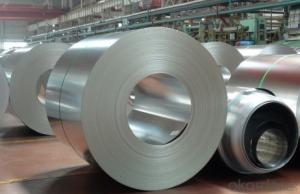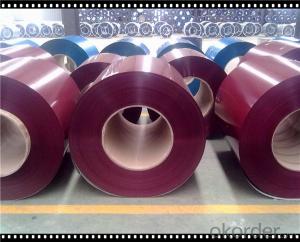Thickness: 0.15 - 2.0 mm
Technique: Hot Rolled
Application: Container Plate
Surface Treatment: Galvanized
Secondary Or Not: Non-secondary
Certification: CE
Special Pipe: Thick Wall Pipe
Alloy Or Not: Non-alloy
Section Shape: Other
Galvanized Steel Coil Cold Rolled Sphc CNBM
- Loading Port:
- Guangzhou
- Payment Terms:
- TT OR LC
- Min Order Qty:
- 20 m.t.
- Supply Capability:
- 3000 m.t./month
OKorder Service Pledge
OKorder Financial Service
You Might Also Like
1.Quick Details:
2.Packaging & Delivery
| Packaging Details: | standard package |
|---|---|
| Delivery Detail: | 1-4 week |
cold rolled galvanizing steel coil
galvanized iron steel coil
Thickness | 0.15mm--2.0mm |
Width | 50--1250mm |
Zinc Coating | 40gsm—275gsm |
Spangle | Big, small regular spangle and zero spangle |
Surface Treatment | Chromate, Galvanized, Skin Pass, Passivity and Oiled(un-oiled) |
ID | 508mm or 610mm |
Coil Weight | 3--7 Metric Tons and as requirements |
Production | 12,000 metric tons per month |
More information of Galvanized Steel Coils/GI/PPGI/HDG | |
Payment Term | T/T or L/C (We usually charge 30% of the deposit first.) |
Delivery Port | Qingdao Port or Tianjin Port |
Delivery Time | Within 20 days after receipt of T/T or L/C |
MOQ | 25 metric tons or one 20 feet container |
Application | General use, Color coating, Corrugated Roofing making, Outside of the buildings Structure, Deep Drawing and etc. |
Ambition | Reliable product, Competitive price, On-time delivery and High standard service. |

5.What is the application of Steel Coil?
There are two sides,one is out side: Workshop, agricultural warehouse, residential precast unit, corrugated roof, roller shutter door, rainwater drainage pipe, retailer booth;the other is inside: Door, doorcase, light steel roof structure, folding screen, elevator, stairway, vent gutter.
- Q: I'm a big fan of stainless steel and sterling silver, but not of the humidity of the country I'm in. Therefore I sweat more. Gross, I know. I'm buying a necklace chain for my ring.So does sweat contribute to tarnishing of silver and steel? The real kind?
- steel shouldn't really tarnish, it rusts and moisture increases that. Silver tarnishes when exposed to air and sulfur. Moisture increases the process a bit, but it happens anyway. Sweat is not gross, it's a necessary function of your body, otherwise you would die. A lot of sports people wear jewelry and they sweat a lot. If you wear the jewelry all the time, that will prevent the tarnish a bit. If you take it off, clean it (water and dish washing liquid), dry it and put it in a zip lock back to keep it away from air and moisture. In the end, cleaning the jewelry is quick and easy so don't worry about it.
- Q: I just got this aftermarket exhaust on my truck and it's recommended that it be welded, but the metal is aluminized steel. How do I mig weld aluminized steel?
- Welding Aluminized Steel
- Q: What are the common defects in steel coils?
- There are several common defects that can occur in steel coils during the manufacturing or handling processes. These defects can affect the quality and performance of the steel, and it is important to identify and address them to ensure the production of high-quality steel products. Some of the common defects in steel coils include: 1. Edge waves or buckles: This defect occurs when the edges of the steel coil become wavy or buckled. It can be caused by improper winding, uneven cooling, or excessive tension during the manufacturing process. Edge waves can lead to difficulties in further processing and affect the appearance of the final product. 2. Coil breaks: Coil breaks are longitudinal breaks or cracks that occur in the steel coil due to excessive strain or stress. These breaks can be caused by improper winding, uneven cooling, or excessive tension during the manufacturing process. Coil breaks can lead to product quality issues and are a major concern in the steel industry. 3. Surface defects: Surface defects in steel coils can include scratches, pits, or stains on the surface. These defects can be caused by improper handling, surface contamination, or inadequate cleaning processes. Surface defects can affect the appearance of the steel and may also lead to corrosion or other performance issues. 4. Slivers: Slivers are thin strips or flakes that can peel off from the edges of the steel coil. They can be caused by poor edge trimming, improper handling, or defects in the rolling mill. Slivers can cause difficulties in further processing and may also affect the surface quality of the final product. 5. Weld defects: In steel coils that are made by welding multiple strips together, weld defects can occur. These defects can include incomplete fusion, porosity, or cracks in the weld area. Weld defects can weaken the steel and affect its mechanical properties, making it unsuitable for certain applications. 6. Shape defects: Shape defects in steel coils can include camber, coil set, or crossbow. These defects can be caused by uneven cooling, improper winding, or tension variations during the manufacturing process. Shape defects can make it difficult to process the steel and may lead to dimensional inaccuracies in the final product. It is essential for manufacturers and users of steel coils to be aware of these common defects and take appropriate measures to prevent or mitigate them. Quality control measures, proper handling procedures, and regular inspections can help in identifying and addressing these defects to ensure the production and use of high-quality steel products.
- Q: How are steel coils protected from chemical damage?
- Steel coils are protected from chemical damage through various methods such as applying protective coatings, using corrosion inhibitors, and storing them in controlled environments to minimize exposure to harmful chemicals.
- Q: my friend needs sensitive ears....she wants to borrow mine but it says surgical steel,what does that mean?
- It means they are hypoallergenic.
- Q: In the warehouse management system of steel coil
- Warehouse is an important component of enterprise material supply system. It is also the tache of enterprise material circulation and storage, and it also undertakes many functions of material management. Its main tasks are to keep the stock well, to be accurate, to be of good quality, to ensure safety, to prompt the people, to produce, to be considerate, to reduce costs, and to speed up capital turnover.
- Q: what is the refining process doing to raw materials in steel
- Refining process for steel include burning out the extra carbon and impurities with oxygen lancing and protecting the steel from atmospheric gas inclusion by protective environment during such process . Measured % of ferralloys are also added to produce various grades of steel . These may be done in induction furnace/ laddle refining furnace / crucibles converters etc.
- Q: I am trying to clean up a stainless steel back splash and some kitchen appliances that have brown spots that look like rust spots. I was able to remove most of them with stainless steel cleaner but does anyone know any tricks?
- Contrary okorder /
- Q: What are the current trends in the steel coil industry?
- Some current trends in the steel coil industry include a growing demand for high-strength and lightweight steel coils, increased focus on sustainability and recyclability, advancements in technology for improved efficiency and productivity, and a shift towards automation and digitalization in manufacturing processes. Additionally, there is a rising preference for customized steel coil solutions to meet specific industry requirements.
- Q: ...particularly for jewelry?
- Steel Reserve (211) the beer...drink responsible...never drive when U had a few Oh I had my ring stolen at a bar It was stainless silver...PeAcE
Send your message to us
Galvanized Steel Coil Cold Rolled Sphc CNBM
- Loading Port:
- Guangzhou
- Payment Terms:
- TT OR LC
- Min Order Qty:
- 20 m.t.
- Supply Capability:
- 3000 m.t./month
OKorder Service Pledge
OKorder Financial Service
Similar products
Hot products
Hot Searches
Related keywords




























